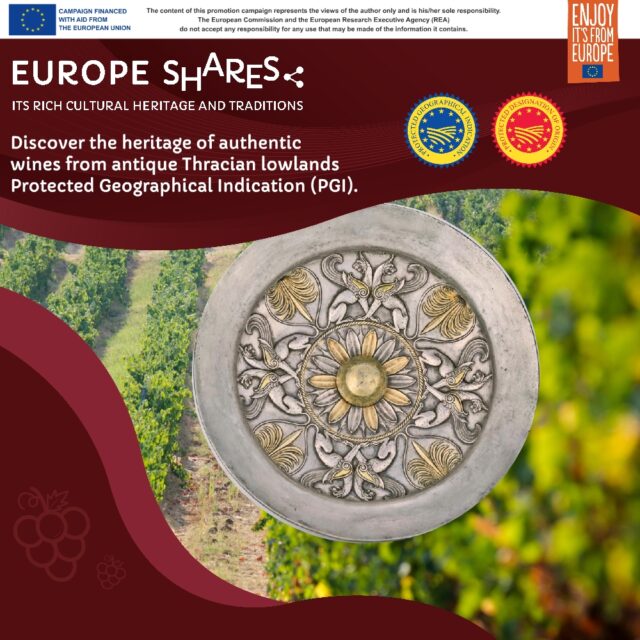Winemakers across Europe, particularly in regions bearing PDO (Protected Designation of Origin) and PGI (Protected Geographical Indication) designations, uphold stringent regulations to safeguard the authenticity and heritage of their wines. In order to protect the names and qualities of specific products and to promote their unique characteristics, linked to their geographical origin and traditions of knowledge the European Union created the quality schemes and labels PDO and PGI. The European Union’s food products regulations are designed to provide a clear structure for the production of organic products throughout the EU. The aim is to satisfy consumer demand for trustworthy products, while providing a fair market for producers, distributors and traders. If you are eager to learn why European wines from the region of Thracian lowlands are marked by PGI read this article!
The unique wines from Thracian lowlands have an immemorial history. This European region has been producing wine for at least 7,000 years. Ancient Thracians who inhabited the lowlands are believed to have been the first winemakers in the world.
The Thracian lowland is a unique wine producing region. Wine has been produced here for millennia, on the sunny hills and fertile soils of the Thracian valley and at the same latitude (equivalent to Central Italy or Southern France). Despite some similarities with other regions of the world in terms of climatic conditions and soils, the Thracian valley is home to some unique indigenous varieties such as Dimyat and Pamid. In this region the climate is temperate-continental with moderate distribution of rainfall. The soils in the area are varied, quite fertile, black-earth resinous soils, cinnamic forest soils, meadow-cinnamic soils, less frequently carbonate soils. In most cases, the soils are conducive to high grape yields for quality red wines. The most popular red grape varieties that can be found in this area are the following : Mavrud, Merlot, Cabernet Sauvignon, Red Muscat, Pamid. The geographical and climatic conditions are conducive to extracting distinctive and characterful, dense and outstanding wines.

For example, wines of the local Mavrud variety are highly valued because they combine the aroma and flavor of red small fruits, spices and herbs. Most often Mavrud grapes are high in tannin with refreshing acidity. The wine is distinguished by its ruby red color and smooth taste. The grapes for it are harvested in the second half of October. The wine is aged in onyx vessels.
Pamid is a historic Thracian indigenous red wine, used to be the most widely cultivated red grape before the appearance of Cabernet Sauvignon and Merlot. Pamid wines have no aging potential, this is why they are consumed within 1-2 years after their production. Pamid produces pleasantly coloured and fruity red wines that are suitable for many of the more substantial dishes. Wine made of Pamid is light red, smooth, easy-drinking and light which makes it suitable for any meal.

White wines of the region are famous for their superb natural freshness and subtle fruitiness. For instance, the wine called Dimyat is particularly favored for its light and sweet taste, often with a vanilla aroma. Dimyat’ grapes are heat-loving and growing in chalky soils. The color of Dimyat is intensely golden, its aroma could include notes of peach, pelargonium roseum and lime.
Thracian wines have become increasingly popular in recent years. This is due to their undeniable strengths and the opening of the European market, as well as the promotion of European products of the highest quality all around the world. To recognize them, don’t forget to look for the labels PGI and PDO – they will ensure the wonderful taste of your wine and its uniqueness. Cheers and Enjoy – it’s from Europe!


The content of this promotion campaign represents the views of the author only and is his/her sole responsibility. The European Commission and the European Research Executive Agency (REA) do not accept any responsibility for any use that may be made of the information it contains.




